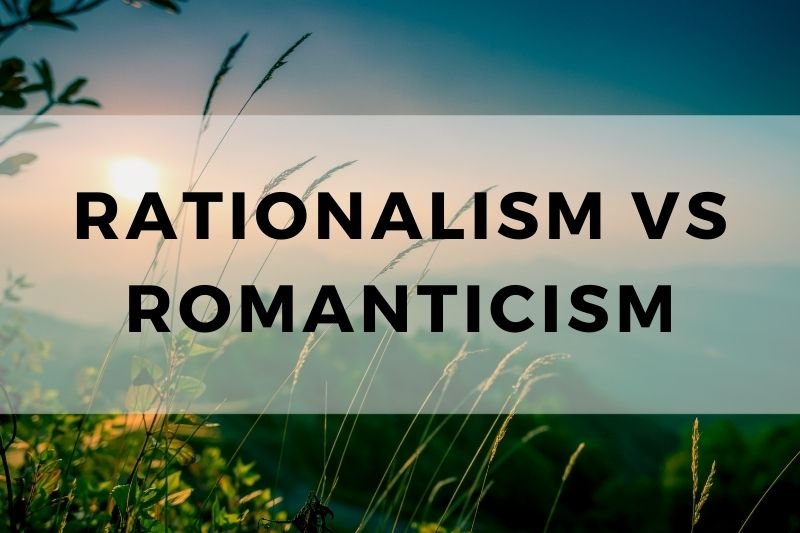
Rationalism and Romanticism represent two distinct ways of understanding the world. Rationalism values reason and logic as the primary sources of knowledge. In contrast, Romanticism prioritizes emotion, intuition, and individual experience. These philosophies shaped not only thought but also art and culture. They stand as opposing forces in how humans engage with reality.
Rationalism focuses on structure and order; Romanticism celebrates freedom and the unknown. This article explores their differences, influences, and lasting impact. Understanding these philosophies helps us navigate the balance between reason and emotion in modern thought.
Definitions
Rationalism
Rationalism is the belief that reason is the chief source of knowledge. It asserts that the mind can discover truths through logic and deduction, independent of sensory experience. Rationalists believe that certain truths are innate or can be known with certainty through intellectual reasoning. Key figures in Rationalism include René Descartes, who famously said, “Cogito, ergo sum” (“I think, therefore I am”). Other influential rationalists include Baruch Spinoza and Gottfried Wilhelm Leibniz. They emphasized that knowledge is not based on observation but on clear, intellectual understanding.
Romanticism
Romanticism, on the other hand, emerged as a reaction against the Enlightenment’s emphasis on reason. It values emotion, intuition, and individual experience above logical thought. Romantic thinkers and artists believe that true knowledge and understanding come from the feelings and experiences that connect us to the world around us. Key figures in Romanticism include poets like William Wordsworth and Samuel Taylor Coleridge, as well as philosophers like Jean-Jacques Rousseau. Romanticism celebrates freedom, imagination, and the sublime in nature and human experience.
Key Differences Between Rationalism and Romanticism
#1. Source of Knowledge
Rationalism asserts that reason is the chief source of knowledge. Rationalists believe that truth can be discovered through logical deduction and intellectual reasoning. In contrast, Romanticism values emotion and intuition. Romantics trust that personal feelings and experiences provide deeper truths that reason alone cannot capture.
#2. Role of Emotion
Rationalism limits the role of emotion in acquiring knowledge. For Rationalists, emotions are considered subjective and unreliable, often leading to error. Romanticism, however, places emotion at the core of understanding. Romantics believe that emotions are essential for accessing truths about the human experience and the world around us.
#3. View of Nature
Rationalists see nature as an objective reality, governed by clear laws and principles that can be understood through reason. They focus on categorizing and explaining the natural world. Romantics, on the other hand, perceive nature as a source of inspiration, beauty, and spiritual connection. Nature is seen not just as a system, but as something that evokes deep emotional responses and a sense of the sublime.
#4. Focus on the Individual
Romanticism places great emphasis on the individual. Romantics celebrate personal experience, individual expression, and the unique voice of the self. Rationalism, by contrast, focuses on universal truths that apply to all humans, often minimizing individual differences in favor of broader, objective knowledge.
#5. Attitude Toward Science
Rationalism encourages scientific exploration and empirical evidence. It believes science, grounded in reason, is the best method to understand the world. Rationalists view scientific inquiry as a means to uncover truths about reality. Romanticism, while not dismissing science, critiques its overreliance on reason. Romantics question whether science can fully capture the complexity of human emotion and the richness of experience.
#6. Perception of the Divine
Rationalists often adopt a more detached, skeptical view of religion. They focus on reason and sometimes view religious beliefs as a product of human thought rather than divine revelation. Romantics, in contrast, are more likely to embrace spirituality. They seek a deeper, emotional connection to the divine and view religion as a means of accessing personal truth and a higher sense of meaning.
#7. Emphasis on Order vs. Freedom
Rationalism values order, structure, and clarity. It seeks to bring understanding through methodical reasoning and precise logic. Romanticism, however, celebrates freedom and spontaneity. Romantics reject rigid structures, advocating for creativity, imagination, and a more fluid approach to understanding the world. Freedom of expression is central to Romantic thought.
#8. Art and Aesthetics
Rationalist art often emphasizes realism, structure, and logic. Artists influenced by Rationalism focus on representing the world as it truly is, using reason to shape their works. Romantic art, in contrast, is more expressive, imaginative, and abstract. Romantic artists explore themes of emotion, the sublime, and nature, often breaking from conventional forms to capture personal expression and emotional depth.
#9. Legacy in Modern Thought
Rationalism laid the foundation for modern science, philosophy, and logic. Its influence is evident in the development of the scientific method and rational inquiry. Romanticism, however, made a significant impact on art, literature, and culture. Its focus on individuality, emotion, and nature continues to shape modern creative fields and personal philosophies, promoting a more subjective approach to understanding life.
#10. Social and Political Views
Rationalism often supports the idea of progress through reason, advocating for social and political reforms based on logical reasoning and empirical evidence. It tends to favor structures that encourage rational thought and order. Romantics, on the other hand, often critique societal structures, focusing on individual freedom and expressing dissatisfaction with established norms. They promote change through personal expression and emotional depth, challenging the status quo in favor of greater freedom.
Rationalism vs Romanticism: Impact on Art and Literature
Rationalism
Rationalism had a significant influence on Enlightenment-era art and literature. During this period, artists and writers focused on clarity, reason, and order. Art was often realistic, structured, and aimed at representing the world objectively. Writers sought to convey logical ideas and moral lessons. Rationalist literature valued precision and intellectual engagement, often highlighting themes of reason, progress, and scientific discovery. The emphasis was on human capacity for rational thought, and works often sought to educate as much as to entertain.
Romanticism
Romanticism, in contrast, revolutionized art and literature by prioritizing emotion, imagination, and personal expression. Romantic artists focused on capturing the sublime, the mysterious, and the emotional intensity of human experience. In literature, themes of individualism, nature, and the unknown were central. Writers sought to express personal feelings and challenge societal norms. Romanticism also emphasized the beauty of the natural world, often portraying it as a source of deep emotional and spiritual connection. Romantic literature was more about inspiring awe and reflection than presenting logical arguments.
The Role of Nature in Both Philosophies
Rationalism
Rationalism takes an objective view of nature. Nature is seen as a system that operates according to fixed laws and principles. Rationalists believe that these laws can be understood through reason and logic. The natural world is something to be analyzed, categorized, and explained. While nature is acknowledged as important, it is primarily valued for its ability to be studied and understood scientifically.
Romanticism
Romanticism, on the other hand, sees nature as a source of deep emotional and spiritual connection. Nature is not just a system to be understood, but a powerful force that inspires awe, wonder, and personal reflection. Romantics view nature as an expression of the sublime, a realm where humans can connect with something greater than themselves. For them, nature is an antidote to the artificiality of modern life and a path to personal and emotional freedom.
Rationalism and Romanticism in Modern Times
Both Rationalism and Romanticism continue to influence modern thought. Rationalism shaped the development of modern science and philosophy. It underpins much of today’s scientific inquiry and logical reasoning. In contrast, Romanticism’s legacy is felt in the arts, literature, and personal expression. Its emphasis on emotion, individuality, and creativity persists in contemporary culture, inspiring movements in art, literature, and even politics.
Rationalism remains central to the fields of technology, mathematics, and natural sciences, where logic and reason dominate. Romanticism, however, still thrives in the creative world. The desire for self-expression and exploration of emotion influences writers, musicians, and visual artists alike.
Both philosophies also play a role in the ongoing debate over the role of reason and emotion in decision-making. Modern discussions about artificial intelligence, ethics, and human identity often reflect the tensions between these two approaches. Rationalism’s structured problem-solving faces off against Romanticism’s value of intuition and emotion. The balance between the two continues to shape our understanding of the world.
Closing Thoughts
Rationalism and Romanticism represent two fundamentally different approaches to understanding the world. Rationalism values reason, logic, and objective knowledge, while Romanticism emphasizes emotion, intuition, and personal experience. Both have shaped art, literature, and philosophy in lasting ways.
Today, we still see their influence in our culture, from scientific advancements to the exploration of personal identity. Striking a balance between these two philosophies remains essential in addressing the complexities of modern life. Understanding their differences helps us appreciate the diverse ways in which we perceive and navigate the world around us.
